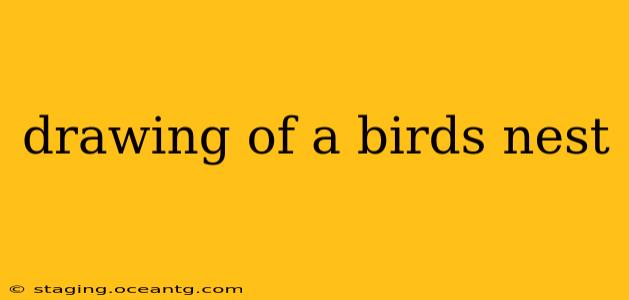Drawing a bird's nest might seem simple, but capturing its intricate details and natural textures requires observation and skill. This guide will walk you through the process, from basic shapes to adding realistic features, catering to artists of all skill levels. We'll explore different approaches and techniques to help you create a stunning avian artwork.
What Materials Will I Need?
Before you begin, gather your materials. The specific tools depend on your preferred style and medium, but here's a versatile selection:
- Paper: Choose a paper weight that can handle your chosen medium without buckling. Smooth paper is ideal for detailed pencil work, while textured paper works well for charcoal or pastels.
- Pencils: A range of pencils (H for light sketching, B for dark shading) will give you control over tone and detail. Consider using a graphite stick for broader strokes.
- Eraser: A kneaded eraser is excellent for lifting graphite and blending. A vinyl eraser is good for sharp lines and erasing large areas.
- Optional Materials: Colored pencils, charcoal, pastels, watercolors, or ink can be used to add color and texture.
Basic Shapes and Construction: How to Start
-
Overall Shape: Begin by lightly sketching the overall shape of the nest. Most nests are cup-shaped, but their exact form varies widely depending on the bird species. Consider an oval, round, or even a somewhat irregular shape.
-
The Foundation: Many nests have a base layer of larger twigs or branches. Sketch these lightly, indicating their intertwining and varied lengths.
-
The Walls: Add the intertwining twigs and grasses that form the walls of the nest. Don't be afraid to overlap lines to show depth and complexity. Vary the thickness and direction of the twigs for a more realistic look.
-
The Interior: The inside of the nest is often more tightly woven, creating a smooth, bowl-like area. Indicate this with finer lines and subtle shading.
Adding Details and Texture: Bringing Your Nest to Life
Once you have the basic structure, it's time to add details that bring the drawing to life.
-
Individual Twigs and Grasses: Focus on individual twigs and grasses. Vary their thickness, texture, and direction to create a realistic impression of natural materials.
-
Shading and Highlights: Use shading to create depth and volume. Pay attention to the way light falls on the nest, highlighting raised areas and darkening recesses. This will make the nest appear three-dimensional.
-
Materials: Consider the materials used by the bird – mud, moss, feathers, leaves, etc. Incorporate these elements to enhance realism and reflect the species of bird that built the nest.
-
The Background: A simple background can enhance the overall composition of your drawing. Consider a tree branch, foliage, or a textured surface.
How to Draw Different Types of Bird Nests?
The construction of bird nests varies widely depending on the species. Some are simple cups, others are more complex structures. Observe images of different nests to understand the variations in shape, size, and materials used. Pay attention to:
- Cup Nests: These are the most common type, typically made from twigs, grass, and leaves.
- Platform Nests: Larger nests built on branches, often using larger twigs and branches.
- Pendant Nests: Hanging nests that are suspended from branches.
- Cavity Nests: Nests built inside tree hollows or crevices.
What are some common mistakes to avoid when drawing a bird's nest?
A common mistake is to make the nest too uniform and symmetrical. Real nests are often irregular and asymmetrical. Avoid making all the twigs the same size and shape. Also, pay attention to perspective – twigs farther away should appear smaller and less detailed.
Conclusion: Practice Makes Perfect!
Drawing a bird's nest is a rewarding challenge. By following these steps and practicing regularly, you can create a stunning and realistic representation of this intricate natural structure. Remember to observe real bird nests for inspiration and practice your techniques to refine your skills. The more you draw, the better you'll become at capturing the beauty and complexity of nature's creations.
